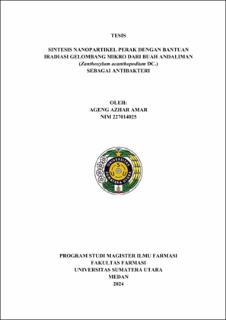Sintesis Nanopartikel Perak Dengan Bantuan Iradiasi Gelombang Mikro Dari Buah Andaliman (Zanthoxylum acanthopodium DC.) Sebagai Antibakteri
Synthesis Of Silver Nanoparticles Using Microwave Irradiation From Andaliman Fruit (Zanthoxylum acanthopodium DC.) as an Antibacterial

Date
2024Author
Amar, Ageng Azhar
Advisor(s)
Putra, Effendy De Lux
Satria, Denny
Metadata
Show full item recordAbstract
Silver nanoparticles are nano-scaled silver particles with therapeutic properties, one of which is antimicrobial activity. The formation of silver nanoparticles requires a reducing agent to convert silver ions into silver nanoparticles. Plants are highly recommended as reducing agents due to their eco-friendly nature. This study aims to investigate the formation of silver nanoparticles mediated by andaliman fruit (Zanthoxylum acanthopodium DC.) using microwave irradiation at 450 Watt (80oC) for 5 minutes and evaluate their antibacterial activity against Staphylococcus aureus, Staphylococcus epidermidis, and Propionibacterium acnes. The silver nanoparticles exhibited a maximum peak spectrum at 430 nm. A reduction in intensity and shifts in the phenolic group position were observed in the Fourier Transform Infrared (FTIR) analysis. The particle size measurement using Particle Size Analyzer showed a size of 55.67 nm, with a cubic crystal structure confirmed by X-Ray Diffraction (XRD) analysis. Transmission Electron Microscopy (TEM) revealed internal morphology sizes of 20.62 ± 10.93 nm and external morphology sizes of 73.078 ± 17.90 nm, with spherical shapes confirmed through Scanning Electron Microscopy (SEM). Zeta potential analysis showed a charge of -0.6 mV. Antibacterial activity was assessed by determining the Minimum Inhibitory Concentration (MIC) and Minimum Bactericidal Concentration (MBC). Andaliman silver nanoparticles and clindamycin exhibited strong MIC and MBC values against all tested bacterial isolates, with MIC values of 1.9 µg/mL and MBC values of 3.9 µg/mL for andaliman silver nanoparticles, and MIC and MBC values of 3.9 µg/mL for clindamycin. Additionally, andaliman silver nanoparticles and clindamycin showed potential in inhibiting biofilm formation (2 MIC) and inducing cell leakage of DNA (4 MIC) and protein (4 MIC) in all tested bacterial isolates. These findings demonstrate that andaliman fruit effectively reduces silver ions into silver nanoparticles, which are proven successful in antibacterial, antibiofilm, and cell leakage prevention tests for DNA and proteins, highlighting their significant potential as a multifunctional antimicrobial agent
Collections
- Magister Theses [371]
